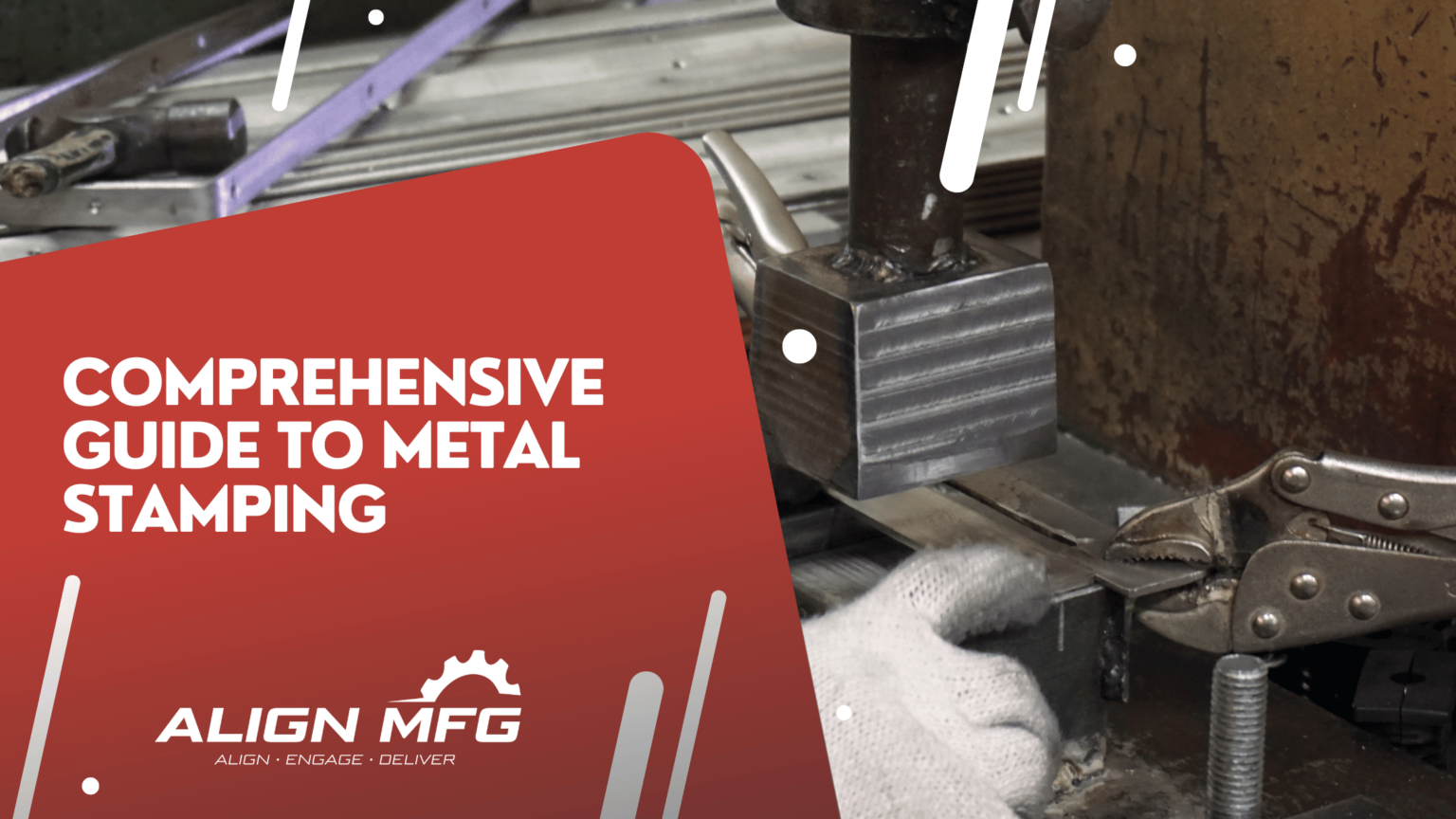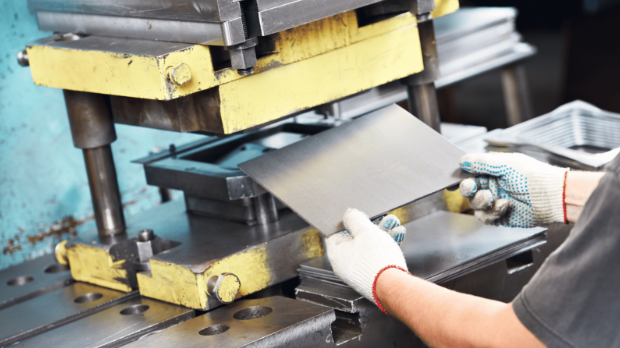
Comprehensive Guide to Stamping
What is Stamping?
Stamping is a crucial manufacturing technique that transforms flat metal sheets or coils into specified shapes. This process encompasses several methods, including punching, blanking, bending, and piercing, utilizing machinery equipped with dies. It is a versatile method extensively employed across various industries to produce large volumes of uniform parts with exceptional accuracy. The process involves a sequence of operations that shape the metal sheet by deforming it plastically into the desired configuration.
Also, the global metal stamping market was valued at USD 213.8 billion in 2023 and is projected to reach USD 257.1 billion by 2028, growing at a CAGR of 3.7% from 2023 to 2028, indicating strong and sustained demand for stamping solutions across various industries.
Benefits of Stamping

It presents numerous advantages, such as:
- Economic Efficiency: Highly suitable for large-scale production, which lowers the price per unit significantly. The initial investment in tooling and equipment is offset by the reduced per-part cost when manufacturing in high volumes.
- High Precision: Capable of producing intricate parts with precise tolerances. This precision ensures that parts meet exact specifications and function as intended in their applications.
- Rapid Production: Ensures high-speed manufacturing while maintaining consistent quality. The processes can produce thousands of parts per hour, making it ideal for industries that require mass production.
- Versatility: Applicable to a wide range of metals and alloys, making it adaptable for various applications. Different materials can be chosen based on the required properties, such as strength, flexibility, or resistance to corrosion.
- Consistency and Reliability: The use of dies ensures that each part produced is identical, providing high reliability and consistency in large production runs.
Overview of the Stamping Process
The process of metal stamping begins with the design and creation of a die. This die is then installed on a press. Metal sheets are fed into the press, where the die shapes the material into the desired form through a series of operations. The entire process can be automated to improve efficiency and maintain uniformity.
Step-by-Step Explanation of the Process
- Design and Engineering: Crafting detailed designs and specifications for the component and die. This stage involves creating a precise blueprint of the part to ensure it meets all required dimensions and tolerances.
- Die Fabrication: Constructing the die based on the provided design specifications. Dies are typically made from hardened steel and are designed to withstand repeated use.
- Material Selection and Preparation: Choosing and preparing the metal sheets for the process. This includes cutting the sheets to size and ensuring they are free from defects.
- Stamping Execution: Feeding the metal sheets into the press where the die performs the required operations. The press applies force to the die, which shapes the metal sheet into the desired form.
- Post-Stamping Finishing: Applying post-stamping treatments such as cleaning, deburring, and surface finishing to the stamped parts. This step ensures that the parts have the required surface finish and are free from sharp edges or burrs.
The Essence of Die Design
At the heart of stamping lies the design and creation of the die, a specialized tool used to cut, shape, and form metal parts. Accuracy in die design translates directly to the precision of the final stamped product.
Understanding the Role of Dies in the Design Process
Dies serve as the lifeline for the process. They function through a meticulous configuration of the punch, die block, and other components to bring a metal part from concept to reality. Die sets need to be engineered to match exact specifications for the stamping operation to meet stringent manufacturing tolerances.
The Complexity in Die Creation
The intricacies of producing a die encompass the consideration of material properties, intended use of the stamped product, and the specific stamping technique being employed. Advanced computational tools are typically employed to simulate the process before the die is manufactured, ensuring that any potential issues are identified and addressed.
Considerations for Efficient Die Design
Successful die design hinges on several factors. Designers must consider metal flow, the clearance between the punch and die, material thickness, and the necessary force for cutting and shaping. These factors, along with the anticipated volume of production, affect the lifespan and performance of the die, and by extension, the cost-effectiveness of the stamping operation.
Mastery in die design incorporates the use of high-tech software alongside seasoned expertise. Designers balance material properties, anticipated wear and abrasion, and even the type of stamping press that will be used. Such comprehensive planning streamlines the process, minimizes the likelihood of errors, and reduces the need for costly rework.
Diagram 1:Understanding the Role of Dies in the Design Process
Delving into the Diversity of Stamping Operations
The landscape of stamping operations allows fabrication of intricate product designs catering to a multitude of industries. Under the umbrella of this manufacturing process, various specialized stamping operations come to light, each distinct, serving its purpose to shape metal into desired products.
Progressive Stamping
Engaging in a step-by-step approach, progressive stamping transforms metal strips progressively through multiple stations. At each station, a different action - punching, coining, bending - is performed. Finished components are sheared off at the final stage, boasting consistency and high production rates.
Transfer Stamping
It separates individual workpieces from the metal strip and transports them from one station to another using mechanical transport systems. Often utilized for larger components, this method enables different operations to be conducted on a single piece, even from varied angles.
Fine Blanking
Fine blanking stands out for its precision. By exerting immense pressure, it produces edges that are smooth and extremely accurate, unlike conventional methods. Automotive, electronics, and medical industries rely on fine blanking for high-fidelity parts.
Additional Techniques
- Fourslide: A versatile process adapting to intricate parts with multiple bends or twists, incorporating the actions of four sliding tools.
- Deep Draw: Ideal for creating deep, hollow shapes like pots and sinks, using a series of dies to draw the metal into the desired form.
- Short Run: Optimal for small-scale production where the setup and costs of progressive stamping are not justified.
Diverse in approach, each stamping operation molds the metal into final products with varying attributes of precision, efficiency, and design complexity. This tableau of techniques gives manufacturers the flexibility to match any production requirement, fueling innovation across industries.
Types of Materials Used in Stamping
Stamping can be performed on various types of metals, each offering unique properties and benefits:
- Steel: Often used for its strength and durability, making it suitable for automotive and industrial applications. Different grades of steel can be used depending on the required properties, such as tensile strength or hardness.
- Aluminum: Lightweight and corrosion-resistant, aluminum is ideal for aerospace and consumer electronics. Its light weight makes it suitable for applications where reducing overall weight is crucial.
- Copper: Known for its excellent electrical conductivity, copper is commonly used in electrical components and connectors. It is also used for its thermal conductivity in heat exchangers and similar applications.
- Brass: Combines durability and malleability, making it suitable for decorative and functional applications. Brass is often used in applications where both appearance and performance are important.
- Stainless Steel: Resistant to rust and staining, stainless steel is frequently used in kitchenware and medical instruments. Its resistance to corrosion makes it ideal for applications in harsh environments.
Applications of it in Various Industries
Stamping is indispensable in several sectors, including:
Automotive Industry
It is crucial in the production of body panels, engine components, and interior parts. The ability to produce large volumes of high-precision parts makes it essential for the automotive industry, where consistency and quality are paramount.
Electronics Sector
In the electronics sector, stamping is used for manufacturing connectors, enclosures, and heat sinks. The high precision and ability to work with conductive metals like copper make it ideal for producing components that require tight tolerances and reliable performance.
Aerospace Industry
The aerospace industry relies on stamping for the creation of intricate parts for aircraft and spacecraft. Components such as brackets, fasteners, and structural elements benefit from the precision and durability provided by stamping processes.
Consumer Goods Sector
In the consumer goods sector, it is used for the fabrication of kitchen appliances, tools, and various household items. The versatility and efficiency of stamping make it suitable for producing a wide range of consumer products with consistent quality.
Custom Stamping
This involves specialized metal forming processes that utilize unique tooling and techniques to create parts tailored to customer specifications. This method is used across a wide array of industries and applications, ensuring high-volume production needs are met while maintaining precise part specifications.
Automation in Stamping
The integration of automation in stamping has revolutionized the manufacturing process. Automated stamping presses and robotic arms significantly enhance production speed and precision, reducing the need for manual labor. Automation ensures consistent quality, minimizes errors, and allows for real-time monitoring and adjustments, leading to higher efficiency and reduced production costs. Moreover, automated systems can handle complex and repetitive tasks, increasing overall productivity and enabling manufacturers to meet the high demands of modern industries.
Benefits of Automation
- Increased Efficiency: Automated systems can operate continuously, significantly increasing production rates compared to manual operations.
- Improved Quality Control: Automation reduces the likelihood of human error, ensuring that each part meets the required specifications.
- Cost Savings: Although the initial investment in automation technology can be high, the long-term savings in labor costs and increased production efficiency can offset these costs.
- Enhanced Flexibility: Automated systems can be programmed to handle a variety of tasks, making it easier to switch between different production runs.
Ensuring Quality Control
Manufacturers must ensure the precision and durability of metal stamped parts. These characteristics hinge on strict quality control procedures during fabrication. A robust quality control system involves routine inspection at multiple stages of the production cycle and adherence to established manufacturing standards.
Quality Control Throughout the Manufacturing Process
Manufacturers adopt a multi-tiered approach to quality control, applying checks at every stage of the stamping process. From the initial material selection to the final product inspection, each phase undergoes rigorous scrutiny. This ensures that the end product meets exact specifications and performance expectations. Such meticulous oversight can significantly reduce the risk of product failure in the field.
Common Quality Control Measures and Standards
- Dimensional Inspection: Gauges and CMM (Coordinate Measuring Machines) are deployed to verify component dimensions against design specifications.
- Material Verification: To confirm material integrity, tests such as tensile strength and hardness are conducted.
- Surface Inspection: Surface defects are identified through visual checks and technologies like laser scanning.
Advanced Insights and Decision-Making
Comparison with Other Forming Methods
When compared to other forming methods like casting, forging, and precision machining, stamping stands out for its ability to produce large volumes of parts with excellent repeatability and precision. While casting and forging are suitable for producing robust parts, they often require more extensive post-processing. Precision machining, though highly accurate, can be more costly for high-volume production.
Cost Analysis
It generally offers a more cost-effective solution for large-scale production due to its automation capabilities and reduced labor costs. Although the initial tooling costs can be substantial, these are offset by the economies of scale achieved in mass production. The efficiency of stamping in producing large volumes of parts with consistent quality contributes to overall cost savings.
Environmental Considerations
Stamping is an environmentally friendly manufacturing process compared to other methods. The process generates less waste material, and the metal scraps produced can be recycled.These scraps are highly coveted in many industries, particularly the foundry industry, for their value and reusability. Additionally, the energy consumption in stamping is lower than in processes like casting and forging, contributing to a smaller carbon footprint.
Innovation in Stamping
Advancements in technology continue to shape the industry. Computer-aided design (CAD) and computer-aided manufacturing (CAM) software have revolutionized die design, allowing for more complex and precise parts. Additionally, the development of high-strength materials and coatings has extended the life of dies, reducing downtime and maintenance costs.
Future Trends in Stamping
The future of stamping is being shaped by several key trends. The adoption of Industry 4.0 technologies, such as the Internet of Things (IoT) and artificial intelligence (AI), is enhancing the efficiency and capabilities of its operations. These technologies enable predictive maintenance, real-time monitoring, and data-driven decision-making, further optimizing the manufacturing process.
Conclusion
Stamping remains an essential manufacturing technique due to its versatility, efficiency, and precision. This process transforms flat metal sheets into various intricate shapes, making it indispensable across numerous industries such as automotive, electronics, aerospace, and consumer goods. The benefits of it include cost-effectiveness, high-speed production, and the ability to work with a wide range of metals.
At Align MFG, we exemplify the innovative applications and advancements in stamping, driving the industry forward. Overall, it is a highly efficient and reliable method for producing complex parts on a large scale, making it a cornerstone of modern manufacturing. Its integration with automation and continuous innovation ensures that stamping will remain a vital manufacturing process for the foreseeable future.

